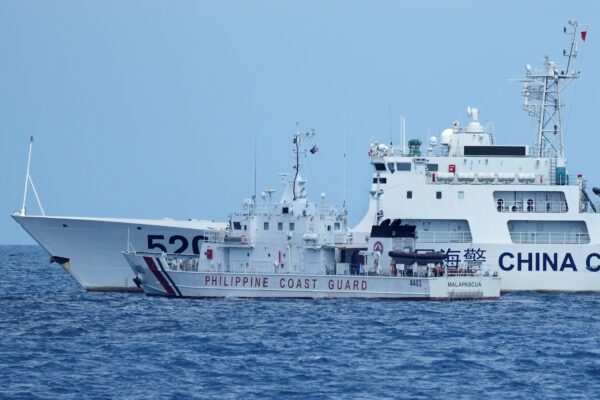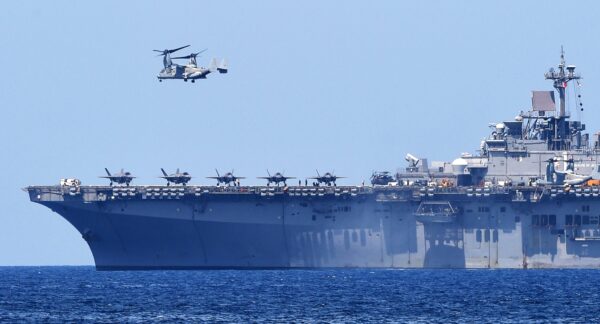US and Philippines Close Ranks Against China
State Department threatens to invoke defense treaty after China Coast Guard provocations Commentary As tensions rise between China and the Philippines over islands and resource rights in the South China Sea, the Biden administration has drawn a line in the sand. In response to standoffs between Chinese and Philippine coast guard ships within the Philippine exclusive economic zone (EEZ), a State Department spokesman said on April 29 that any firing on Philippine Coast Guard vessels would activate a defense treaty. “The United States stands with our Philippine allies in upholding the rules-based international maritime order and reaffirms that an armed attack in the Pacific, which includes the South China Sea, on Philippine armed forces, public vessels, or aircraft, including those of the Coast Guard, would invoke U.S. mutual defense commitments under Article IV of the 1951 U.S. Philippines Mutual Defense Treaty,” the statement read. Such attacks have arguably already occurred on multiple occasions. In February, the Philippines released video evidence of a China Coast Guard ship firing a military-grade laser at the Philippine Coast Guard. Since 1995, China has occupied Philippine territory at Mischief Reef in the South China Sea, not to mention multiple other artificial islands in the Philippines’ EEZ. Article IV of the defense treaty states: “Each Party recognizes that an armed attack in the Pacific Area on either of the Parties would be dangerous to its own peace and safety and declares that it would act to meet the common dangers in accordance with its constitutional processes. Any such armed attack and all measures taken as a result thereof shall be immediately reported to the Security Council of the United Nations. Such measures shall be terminated when the Security Council has taken the measures necessary to restore and maintain international peace and security.” U.S. military forces could therefore be called upon to defend Philippine coast guard vessels from the China coast guard, naval, or maritime militia vessels, all of which fall under the command of the People’s Liberation Army (PLA) Navy. Given that China and Russia would likely veto any United Nations Security Council action in defense of the Philippines, it remains to be seen if the United States and a coalition of the willing—with the United Kingdom, Japan, and Australia as likely participants—will defend the Philippines against the PLA’s ongoing aggression. A Chinese Coast Guard ship with bow number 5201 blocks Philippine Coast Guard ship BRP Malapascua as it maneuvers to enter the mouth of the Second Thomas Shoal, locally known as Ayungin Shoal, at the South China Sea on April 23, 2023. (Aaron Favila/AP Photo) The State Department language that includes mention of the defense treaty is a notable escalation on the South China Sea issue that few media outlets have sufficiently reported, and another that the new Philippine president, “Bongbong” Ferdinand Marcos, Jr., will have a much closer defense relationship to the United States than his bumptious predecessor, Rodrigo Duterte. The latter famously broke with the United States to reorient the Philippines toward China and beg for $180 billion in development loans. Only $422 million came through, however, which disappointed the country’s China advocates and likely disillusioned the Philippine electorate over any hope that China was friendly toward the Philippines. Marcos has increased the intensity of joint military exercises with the United States. On April 28, 18,000 U.S. and Philippine forces completed a three-week military exercise that was the largest ever between the allies. Earlier this month, the United States and the Philippines announced four new U.S. military sites in the Philippines, including on Palawan Island, which abuts the South China Sea, and two locations in the northern Philippines near Taiwan. The two northern sites will provide naval and air support to rotating U.S. forces, which will help deter a Chinese invasion of Taiwan. A V-22 Osprey takes off from the USS Wasp as part of the annual joint U.S.-Philippines military exercise on the shores of San Antonio, facing the South China Sea, in Zambales province, Philippines, on April 11, 2019. (Ted Aljibe/AFP via Getty Images) The fourth site is in central Luzon, north of Manila, that could provide backup to the two northern sites and support Marcos’ reinvigorated campaign against local communist guerrillas that have waged a 50-year war on Manila. The Chinese Communist Party’s broken promises, territorial aggression against most of its neighbors, and claim to regional hegemony in Asia are causing an arms race between not only the United States and China, but among China’s neighbors, which are attempting to deter any further Chinese territorial aggression through closer defense cooperation. Japan, India, Bhutan, Vietnam, Indonesia, Malaysia, Brunei, and Taiwan also have territorial disputes with China. The

State Department threatens to invoke defense treaty after China Coast Guard provocations
Commentary
As tensions rise between China and the Philippines over islands and resource rights in the South China Sea, the Biden administration has drawn a line in the sand.
In response to standoffs between Chinese and Philippine coast guard ships within the Philippine exclusive economic zone (EEZ), a State Department spokesman said on April 29 that any firing on Philippine Coast Guard vessels would activate a defense treaty.
“The United States stands with our Philippine allies in upholding the rules-based international maritime order and reaffirms that an armed attack in the Pacific, which includes the South China Sea, on Philippine armed forces, public vessels, or aircraft, including those of the Coast Guard, would invoke U.S. mutual defense commitments under Article IV of the 1951 U.S. Philippines Mutual Defense Treaty,” the statement read.
Such attacks have arguably already occurred on multiple occasions. In February, the Philippines released video evidence of a China Coast Guard ship firing a military-grade laser at the Philippine Coast Guard. Since 1995, China has occupied Philippine territory at Mischief Reef in the South China Sea, not to mention multiple other artificial islands in the Philippines’ EEZ.
Article IV of the defense treaty states: “Each Party recognizes that an armed attack in the Pacific Area on either of the Parties would be dangerous to its own peace and safety and declares that it would act to meet the common dangers in accordance with its constitutional processes. Any such armed attack and all measures taken as a result thereof shall be immediately reported to the Security Council of the United Nations. Such measures shall be terminated when the Security Council has taken the measures necessary to restore and maintain international peace and security.”
U.S. military forces could therefore be called upon to defend Philippine coast guard vessels from the China coast guard, naval, or maritime militia vessels, all of which fall under the command of the People’s Liberation Army (PLA) Navy.
Given that China and Russia would likely veto any United Nations Security Council action in defense of the Philippines, it remains to be seen if the United States and a coalition of the willing—with the United Kingdom, Japan, and Australia as likely participants—will defend the Philippines against the PLA’s ongoing aggression.

The State Department language that includes mention of the defense treaty is a notable escalation on the South China Sea issue that few media outlets have sufficiently reported, and another that the new Philippine president, “Bongbong” Ferdinand Marcos, Jr., will have a much closer defense relationship to the United States than his bumptious predecessor, Rodrigo Duterte.
The latter famously broke with the United States to reorient the Philippines toward China and beg for $180 billion in development loans. Only $422 million came through, however, which disappointed the country’s China advocates and likely disillusioned the Philippine electorate over any hope that China was friendly toward the Philippines.
Marcos has increased the intensity of joint military exercises with the United States. On April 28, 18,000 U.S. and Philippine forces completed a three-week military exercise that was the largest ever between the allies.
Earlier this month, the United States and the Philippines announced four new U.S. military sites in the Philippines, including on Palawan Island, which abuts the South China Sea, and two locations in the northern Philippines near Taiwan. The two northern sites will provide naval and air support to rotating U.S. forces, which will help deter a Chinese invasion of Taiwan.

The fourth site is in central Luzon, north of Manila, that could provide backup to the two northern sites and support Marcos’ reinvigorated campaign against local communist guerrillas that have waged a 50-year war on Manila.
The Chinese Communist Party’s broken promises, territorial aggression against most of its neighbors, and claim to regional hegemony in Asia are causing an arms race between not only the United States and China, but among China’s neighbors, which are attempting to deter any further Chinese territorial aggression through closer defense cooperation. Japan, India, Bhutan, Vietnam, Indonesia, Malaysia, Brunei, and Taiwan also have territorial disputes with China.
The CCP’s ambition to impose itself as a regional hegemon by keeping other superpowers out of Asia was on display in its response to the State Department release.
On April 30, China’s foreign ministry spokesperson issued a written statement saying, “The U.S., as a country outside of the region, must not interfere with the South China Sea matter or use the South China Sea matter to sow discord among regional countries.”
Beijing and Moscow are trying to assert that they have spheres of influence, much as the United States had in the 19th century over Latin America, that would preclude involvement from the United States and the European Union in Asia or the former Soviet republics. Some of their officials and analysts would even claim that countries in these regions lack sovereignty as regional power concentrates in Beijing and Moscow.
The countries of these regions would beg to differ and are backed by international law and the military and economic power of the United States, the European Union, and allies like Japan and South Korea. As long as Beijing and Moscow do not bribe their way to victory, the democracies of the world can and must resist their attempts at regional hegemony, which could turn into wars for global hegemony at some point in the future.
A lasting peace can likely only be achieved when Moscow and Beijing democratize and thus become part of the supporters of peace, democracy, and human rights globally rather than their main detractors.
Views expressed in this article are the opinions of the author and do not necessarily reflect the views of The Epoch Times.












